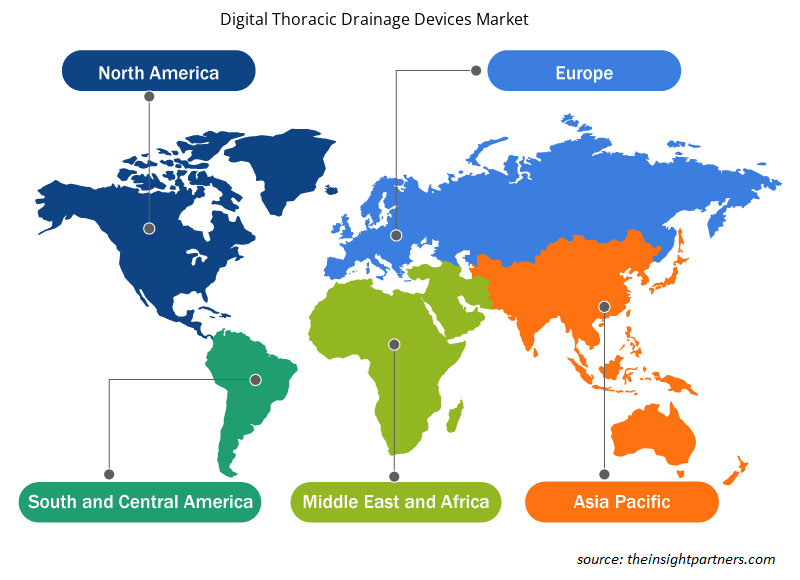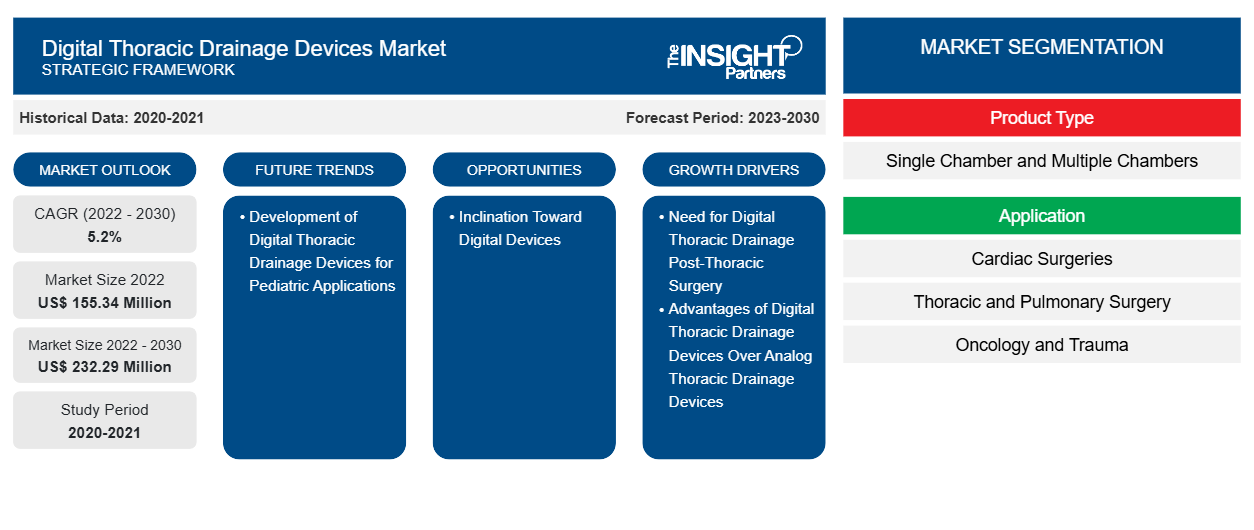[研究报告] 数字胸腔引流装置的市场规模预计将从 2022 年的 1.5534 亿美元增至 2030 年的 2.3229 亿美元。预计 2022 年至 2030 年期间的复合年增长率为 5.2%。
市场洞察和分析师观点:
数字胸腔引流管可提供精确、稳定的负压,不受患者位置影响,不会堵塞任何管子。胸腔或胸腔引流管可排出心脏或肺部周围的空气、液体或血液,帮助维持正常的呼吸功能和血流动力学稳定性。这些系统比传统系统有几个优点。它们可以连续记录漏气情况;这种能力有助于减少医生对是否需要拔除胸管的判断差异。胸腔引流系统主要用于治疗重症监护病房 (ICU)、急诊科和手术室的患者。现代设备的接受度提高、心血管疾病 (CVD) 患病率上升以及自发性气胸负担激增是推动数字胸腔引流设备市场增长的主要因素。数字胸腔引流设备安全、舒适,患者耐受性良好。此外,它们有助于减少或消除住院费用。
增长动力和机遇:
由于肺癌发病率上升,胸部手术的数量正在增加。约 80% 的胸部手术是为了治疗不同类型的肺癌而进行的。肺癌的主要类型包括食道癌和在心包、胸壁和纵隔肿瘤中诊断出的癌症。根据世界癌症研究基金会国际组织的数据,肺癌是全球第二大常见癌症。随着该疾病的流行和诊断率的激增,全球胸部手术的数量显着增加。根据 2022 年 1 月发表在《胸腔疾病杂志》上的研究文章“美国胸外科手术简介”,美国每年进行近 530,000 例普通胸部手术。随着肺癌发病率的上升,未来几年胸部手术的数量将继续增加。因此,随着肺癌发病率的上升,对数字胸腔引流装置的需求也在增加
随着相关技术的进步和技术的改进,胸外科领域正在不断发展,成为一门重要的专业。由于微创方法的发展,胸外科取得了进步。选择性肺段切除术、增强康复计划、单孔手术和辅助靶向治疗等手术可以治疗早期肺癌,导致胸部手术的数量不断增加。此外,与十年前相比,技术的进步使得现在进行的胸部手术效果好得多。大多数胸部手术都是由机器人或电视辅助胸腔镜手术 (VATS) 肺叶切除术进行的,这可以减少并发症并加快恢复速度。胸腔引流装置是术后必不可少的,以清除胸腔中的大量漏气和过多的液体。
除了肺癌,胸腔手术还用于治疗心血管疾病和其他慢性疾病。这些手术还包括胸廓出口综合征的第一肋骨切除术、贲门失弛缓症的肌切开术、终末期良性食管疾病的食管切除术和重建术、重症肌无力的胸腺切除术、多汗症的交感神经切除术等。这些疾病在老年人、呼吸系统疾病和其他健康问题患者中很常见。因此,老年人口的增加引发了作为治疗手段的胸腔手术数量,从而导致对数字胸腔引流装置的需求。
定制此报告以满足您的需求
您可以免费定制任何报告,包括本报告的部分内容、国家级分析、Excel 数据包,以及为初创企业和大学提供优惠和折扣
-
获取此报告的关键市场趋势。这个免费样品将包括数据分析,从市场趋势到估计和预测。
报告细分和范围:
根据产品类型,数字胸腔引流装置系统市场分为单腔和多腔。根据应用,市场细分为胸肺外科、传染病、肿瘤和创伤、心脏外科等。根据最终用户,数字胸腔引流装置市场细分为医院、门诊手术中心等。就地域而言,数字胸腔引流装置系统市场细分为北美(美国、加拿大和墨西哥)、欧洲(法国、德国、英国、西班牙、意大利和欧洲其他地区)、亚太地区(中国、印度、日本、澳大利亚、韩国和亚太其他地区)、中东和非洲(沙特阿拉伯、阿联酋、南非和中东和非洲其他地区)以及南美洲和中美洲(巴西、阿根廷和南美洲和中美洲其他地区)。
节段分析:
按产品类型划分,数字胸腔引流装置市场分为单腔和多腔。单腔部分在 2022 年占据了更大的市场份额。此外,预计多腔部分在预测期内的复合年增长率会更高。单腔系统是胸腔引流系统的最基本设计。它有一个收集容器,要么是 Heber 引流管,要么是主动抽吸源。水封组件的连接允许主动或被动抽气。使用 Heber 引流管时可能需要手动协助以确保吸出所有空气。当患者无法呼气或咳出多余的空气时,可能需要调整床与地面之间的高度以防止气胸或皮下气肿。一些单腔系统在处理大量漏气时存在局限性,因为它们并不总是容易检测到,尤其是当患者产生大量泡沫时。
根据应用,数字胸腔引流设备市场细分为胸肺外科、传染病、肿瘤和创伤、心脏外科等。胸肺外科领域在 2022 年占据最大市场份额,预计在预测期内将实现最高复合年增长率。 胸腔手术和肺部手术(包括冠状动脉搭桥术、心肺移植和癌性肺组织切除)数量的不断增长推动了胸腔引流装置的采用。根据 2022 年 1 月发表的题为“美国胸外科手术简介”的研究,美国每年有近 4,000 名心胸外科医生进行约 530,000 例普通胸外科手术。数字胸腔引流装置有助于治疗胸腔积液和脓胸问题。根据美国哮喘和过敏基金会 2022 年 4 月发布的数据,每 13 个美国人中就有 1 人患有哮喘,即总共约 2600 万人。因此,预计预测期内对胸腔引流装置的需求将增加。因此,上述因素推动了胸肺外科领域数字胸腔引流装置市场的增长。
按最终用户划分,数字胸腔引流设备市场分为医院、门诊手术中心和其他。医院部门在 2022 年占据了最大的市场份额,预计在预测期内将实现 5.6% 的最高复合年增长率。医院的医务人员为患者提供便捷的服务和最好的护理,以恢复和维护良好的公共卫生。此外,这些设施中的工作人员了解用于各种应用的不同数字胸腔引流设备。他们还接受了教育和培训,以应对使用新设备后可能出现的并发症。人口的增加增加了对医疗保健服务的需求,进一步推动了对医院和工作人员的需求。因此,预计医院部门的数字胸腔引流设备市场在预测期内将经历显着增长。
区域分析:
北美在全球数字胸腔引流设备市场中占据主导地位。2022 年北美数字胸腔引流设备市场规模为 5110 万美元,预计到 2030 年将达到 7770 万美元;预计在预测期内复合年增长率为 5.4%。北美数字胸腔引流设备市场分为美国、加拿大和墨西哥。北美市场的增长归因于最新医疗器械技术的日益普及,以及肺癌、心血管疾病和慢性呼吸系统疾病等慢性病发病率的不断上升。此外,墨西哥旅游业可能会为该地区的数字胸腔引流设备市场增长提供机会。此外,亚太地区数字胸腔引流设备市场分为中国、日本、印度、韩国、澳大利亚和亚太地区其他地区。该地区数字胸腔引流设备市场规模的增长归因于呼吸系统疾病病例的激增、手术数量的增加、医疗保健行业的扩张以及对数字胸腔引流设备认识的不断提高。
行业发展和未来机遇:
以下是全球数字胸腔引流设备市场的主要参与者采取的各种举措。
- 2023 年 2 月,Centese, Inc. 开发的 Thoraguard 智能胸管管理系统因其在肺部手术后的使用而被一些同行评审期刊引用。根据纽约大学朗格尼健康中心 (NYU Langone Health) 胸外科团队在《胸腔疾病杂志》上发表的一项研究,Thoraguard 的数字漏气测量技术比传统的引流设备更可靠、更精确,减少了住院时间。
- 2020 年 12 月,美德乐推出了 Thopaz+ 数字胸腔引流管,该设备提高了安全性,并有助于在 COVID-19 疫情期间防止交叉污染。多项定量测试证明,Thopaz+ 的过滤系统可有效阻挡气溶胶病毒颗粒(例如 SARS-CoV-2)。通过其过滤系统,患者和工作人员可以免受交叉污染和传染性气溶胶的传播。
数字胸腔引流设备市场区域洞察
Insight Partners 的分析师已详尽解释了预测期内影响数字胸腔引流设备市场的区域趋势和因素。本节还讨论了北美、欧洲、亚太地区、中东和非洲以及南美和中美洲的数字胸腔引流设备市场细分和地理位置。

- 获取数字胸腔引流装置市场的区域特定数据
数字胸腔引流装置市场报告范围
| 报告属性 | 细节 |
|---|---|
| 2022 年市场规模 | 1.5534 亿美元 |
| 2030 年市场规模 | 2.3229亿美元 |
| 全球复合年增长率(2022 - 2030 年) | 5.2% |
| 史料 | 2020-2021 |
| 预测期 | 2023-2030 |
| 涵盖的领域 |
按产品类型
|
| 覆盖地区和国家 |
北美
|
| 市场领导者和主要公司简介 |
|
数字胸腔引流设备市场参与者密度:了解其对业务动态的影响
数字胸腔引流设备市场正在快速增长,这得益于终端用户需求的不断增长,这些需求源于消费者偏好的不断变化、技术进步以及对产品优势的认识不断提高等因素。随着需求的增加,企业正在扩大其产品范围,进行创新以满足消费者的需求,并利用新兴趋势,从而进一步推动市场增长。
市场参与者密度是指在特定市场或行业内运营的企业或公司的分布情况。它表明在给定市场空间中,相对于其规模或总市场价值,有多少竞争对手(市场参与者)存在。
在数字胸腔引流设备市场运营的主要公司有:
- 美德乐公司
- ATMOS 医疗技术有限公司
- 森特斯公司
- 雷达克斯公司
- 火箭医疗公司
免责声明:上面列出的公司没有按照任何特定顺序排列。

- 了解数字胸腔引流设备市场的主要参与者概况
Covid-19的影响:
COVID-19 疫情影响了世界各国的经济和行业。北美、欧洲、亚太地区 (APAC)、南美和中美 (SAM) 以及中东和非洲 (MEA) 的封锁、旅行限制和企业关闭阻碍了包括医疗保健行业在内的多个行业的增长。COVID-19 疫情也对数字胸腔引流设备市场产生了重大影响。由于全球医疗保健系统专注于控制疫情的激增,某些胸外科手术等选择性手术被推迟或取消,导致对胸腔引流设备的需求暂时下降。此外,全球供应链中断导致制造和分销延迟,导致这些设备短缺和成本增加。然而,这些先进的设备在治疗胸腔积液和气胸等疾病方面发挥着关键作用,这些疾病可能是 COVID-19 的严重并发症。通过有效地从胸膜腔中排出多余的液体或空气,这些设备有助于缓解肺部压力并促进呼吸恢复。此外,这些设备的数字功能可以远程监控患者的引流量和其他相关参数,使医护人员能够评估他们的进展情况并及时应对任何变化。这种远程患者管理方法对于最大限度地减少患者和医护人员之间的直接接触至关重要,有助于疫情期间的感染控制工作。总体而言,数字胸腔引流设备显著改善了患者的治疗效果,并为在 COVID-19 疫情早期面临前所未有的挑战的医疗保健系统提供了必要的支持。
竞争格局和重点公司:
数字胸腔引流设备市场中的一些知名公司包括 Medela AG、ATMOS MedizinTechnik GmbH & Co KG、Centese Inc、Redax SpA、Rocket Medical Plc、Getinge AB、Teleflex Inc.、Pacific Hospital Supply Co Ltd、Cardinal Health Inc 和 Digicare Biomedical Technology Inc. 这些公司专注于新产品的推出和地域扩张,以满足全球日益增长的消费者需求,并增加其专业产品组合的产品范围。它们在全球拥有广泛的业务,这有助于它们服务于庞大而多样化的客户群,从而扩大其市场份额。该报告提供了数字胸腔引流设备市场的趋势分析,强调了技术进步、市场动态和全球主要市场参与者的竞争格局分析等参数。
- 历史分析(2 年)、基准年、预测(7 年)及复合年增长率
- PEST和SWOT分析
- 市场规模、价值/数量 - 全球、区域、国家
- 行业和竞争格局
- Excel 数据集
近期报告
相关报告
客户评价
购买理由
- 明智的决策
- 了解市场动态
- 竞争分析
- 客户洞察
- 市场预测
- 风险规避
- 战略规划
- 投资论证
- 识别新兴市场
- 优化营销策略
- 提升运营效率
- 顺应监管趋势























 获取免费样品 - 数字胸腔引流设备市场
获取免费样品 - 数字胸腔引流设备市场